False Sea Thrift Armeria pseudarmeria

ABOUT
Armeria pseudarmeria, commonly known as false sea thrift, is an attractive perennial that forms a low-growing, dense tuft of grass-like leaves. These leaves are dark green, narrow, and linear, creating a lush, neat mound that serves as a backdrop for the prominent flowers. The plant is well-known for its round, globe-like flower clusters that perch atop sturdy, upright stems. These blossoms come in shades of pink, ranging from soft pastels to more intense hues, and they have a delicate, papery texture. The flowering stems are leafless, which makes the flower heads appear to float above the foliage when viewed from a distance. False sea thrift typically blooms in late spring to early summer, offering a long season of visual interest. The overall form of the plant is compact and tidy, making it a favorite for rock gardens, borders, and edging along walkways. The charming appearance of false sea thrift with its showy blooms and evergreen foliage maintains an appealing look throughout the year, even when not in bloom.
About this plant
 Names
NamesFamily
Plumbaginaceae
Synonyms
False Sea Thrift, Sea Thrift, Thrift
Common names
Armeria maritima var. pseudarmeria, Armeria vulgaris subsp. pseudarmeria.
 Toxicity
ToxicityTo humans
Armeria pseudarmeria, commonly known as false sea thrift, is not widely recognized as a toxic plant to humans. There is little to no information readily available on the toxic effects of ingesting this plant in humans. As with any plant, individuals may have varying sensitivities or allergic reactions, so it is always prudent to exercise caution and not consume parts of ornamental plants unless they are known to be edible.
To pets
False sea thrift (Armeria pseudarmeria) is also not widely known to be toxic to pets. There is a lack of specific information on the plant's potential toxicity to animals such as dogs and cats. As always, it is best to prevent pets from ingesting plants that are not recognized as safe for consumption to avoid any possible adverse reactions. If a pet does consume false sea thrift and exhibits any unusual symptoms, it is advisable to consult with a veterinarian.
 Characteristics
CharacteristicsLife cycle
Perennials
Foliage type
Evergreen
Color of leaves
Green
Flower color
Pink
Height
1 foot [30 cm]
Spread
1 foot [30 cm]
Plant type
Herb
Hardiness zones
5
Native area
Europe
Benefits
 General Benefits
General Benefits- Aesthetic Appeal: Armeria pseudarmeria, commonly known as false sea thrift, adds visual interest to gardens with its grass-like foliage and spherical pink or white blooms.
- Drought Tolerance: Once established, false sea thrift is quite tolerant to drought, making it an excellent choice for water-conservative landscaping.
- Low Maintenance: This plant requires minimal care, making it suitable for gardeners of all skill levels.
- Soil Versatility: It can grow in a variety of soil types, although it prefers well-drained soil, giving gardeners flexibility in plant placement.
- Attracts Pollinators: The blooms of false sea thrift attract bees and butterflies, helping to pollinate the garden.
- Seasonal Interest: Its flowers bloom from late spring to early summer, providing seasonal color and interest in the garden.
- Compact Growth: The plant's compact size makes it ideal for borders, rock gardens, or as ground cover.
- Evergreen: In many climates, false sea thrift remains evergreen throughout the year, contributing to the garden's winter interest.
- Edging Plant: Its neat growth habit makes it an excellent choice for edging paths and garden beds.
- Seaside Tolerance: False sea thrift is naturally tolerant to salt and can be used in coastal gardens or landscapes near the ocean.
 Medical Properties
Medical PropertiesThis plant is not used for medical purposes.
 Air-purifying Qualities
Air-purifying QualitiesThis plant is not specifically known for air purifying qualities.
 Other Uses
Other Uses- The dried flowers of thrift (Armeria pseudarmeria) are often used in dried flower arrangements, appreciated for their ability to retain color and shape long after drying.
- Due to their compact and neat growth habit, thrift can be planted in crevices or between pavers in a garden path, providing a splash of color and withstanding light foot traffic.
- Thrift is an excellent choice for rock gardens or alpine garden settings thanks to its tolerance of poor soil and preference for well-draining conditions.
- As a salt-tolerant plant, thrift is ideal for coastal landscapes where other plants might struggle with the saline environment.
- The flowers of thrift are attractive to butterflies and bees, making them a useful addition to a pollinator-friendly garden.
- Tolerant to windy conditions, thrift can be used in gardens that are exposed to harsh winds and still remain visually appealing.
- Thrift can serve as a natural border or edge to a garden bed, forming a neat and low-growing line that defines garden spaces without overshadowing other plants.
- With their evergreen foliage, thrift plants provide year-round interest in a garden, especially in areas where winter colors are limited.
- Pet owners sometimes use thrift in pet-safe garden designs, as it is not known to be toxic to dogs and cats.
- When planted en masse, thrift's cushion-like growth can be used to create a textured ground cover that requires minimal maintenance.
Interesting Facts
 Feng Shui
Feng ShuiThe False Sea Thrift is not used in Feng Shui practice.
 Zodiac Sign Compitability
Zodiac Sign CompitabilityThe False Sea Thrift is not used in astrology practice.
 Plant Symbolism
Plant Symbolism- Resilience: Armeria pseudarmeria, commonly known as "False Sea Thrift" or simply "Sea Thrift", often grows in harsh, seaside environments, symbolizing the ability to endure and thrive in challenging conditions.
- Beauty and Simplicity: With its compact, neat growth habit and small, pink to lavender flowers, Sea Thrift represents the beauty in simplicity and the appreciation of small yet vibrant natural wonders.
- Longevity: Sea Thrift is a perennial plant, returning year after year. It is symbolic of long-lasting life, permanence, and steadfastness.
- Humility: Due to its low-growing nature and unassuming appearance, Sea Thrift is often associated with humility and modesty.
 Water
WaterFalse sea thrift (Armeria pseudarmeria) prefers well-drained soil and does not like to sit in wet conditions, so be cautious not to overwater. During the active growing season in spring and summer, water this plant thoroughly once every week or two, allowing the top inch of soil to dry out between waterings. Adjust the frequency to account for rainfall and check the soil moisture regularly—more frequent watering may be needed in hot, dry periods. When watering, apply the water directly to the soil and avoid getting water on the leaves to prevent fungal diseases. Generally, for outdoor plants, use about one gallon of water per square foot of soil every couple of weeks, adjusting as necessary for weather conditions.
 Light
LightFalse sea thrift thrives in full sunlight, so it is best positioned in a spot where it can receive at least 6 hours of direct sunlight daily. If grown indoors or in a region with intense summer heat, it can also tolerate some partial shade, especially during the hottest part of the day. Ensure that the chosen spot is free from shadows cast by larger plants or structures to guarantee plenty of bright light for the flourishing of this flower.
 Temperature
TemperatureFalse sea thrift is hardy in a range of temperatures and can typically withstand temperatures as low as 15 degrees Fahrenheit to highs around 80 degrees Fahrenheit. The ideal temperature for optimal growth is between 60 and 70 degrees Fahrenheit. It's important to protect the plant from extreme cold by providing mulch or bringing potted specimens indoors if the temperature is expected to drop significantly below the minima.
 Pruning
PruningFalse sea thrift benefits from pruning to stimulate new growth and maintain a tidy appearance. After the bloom period, typically in late spring or early summer, deadhead spent flowers by cutting the flower stalks back to the base. This will encourage a potential second bloom and prevent the plant from self-seeding excessively. Additionally, in late winter or early spring, trim back any dead or damaged foliage to keep the plant healthy and ready for the growing season.
 Cleaning
CleaningAs needed
 Soil
SoilFalse Sea Thrift thrives in well-draining soil with a mix of sand, loam, and compost. A soil pH of 5.5 to 8.0 suits this plant, allowing a broad range of pH levels. Predominantly sandy soil helps to mimic its natural coastal habitats and ensures proper drainage, which is crucial for preventing root rot.
 Repotting
RepottingFalse Sea Thrift does not need frequent repotting and can typically be repotted every 2 to 3 years. It's essential to repot when the plant outgrows its current container or the soil becomes compacted, which may impede drainage. Spring is the best season to repot this perennial to allow it to establish in its new container before the growing season.
 Humidity & Misting
Humidity & MistingFalse Sea Thrift is not particularly demanding regarding humidity and can tolerate a range of humidity levels typical of most outdoor environments. It prefers average air circulation and does not require high humidity, making it suitable for a variety of climates.
 Suitable locations
Suitable locationsIndoor
Provide bright light, well-draining soil, and cool temperatures.
Outdoor
Plant in full sun, well-drained soil, and water sparsely.
Hardiness zone
4-8 USDA
 Life cycle
Life cycleArmeria pseudarmeria, commonly known as false sea thrift or false thrift, begins its life cycle with seed germination, typically in spring, which requires a period of cold stratification to break dormancy. After sprouting, the plant grows into a rosette of evergreen leaves and develops a deep root system which allows it to thrive in well-drained soils. In late spring to early summer, it produces tall stalks topped with round flower heads composed of small, pink to white flowers, attracting pollinators for reproduction. Once pollination occurs, the plant develops seed capsules that release seeds when mature, allowing for propagation. In addition to seed reproduction, false sea thrift can also spread vegetatively through division of its clumps, usually done in spring or after flowering. The plant then enters a period of dormancy during the winter months, although the foliage often remains green, and the cycle begins anew with the next growing season.
 Propogation
PropogationPropogation time
Spring-early summer
The most popular method of propagating False Sea Thrift (Armeria pseudarmeria) is by division. This process is typically done in the spring or fall when the weather is cool. Gardeners should carefully dig up the plant, taking care not to damage the root ball. Once lifted from the ground, the clump can be gently teased apart into smaller sections, ensuring that each new section has a portion of the root system attached. These divisions should then be replanted at the same depth they were growing previously, spaced approximately 12 inches (30 centimeters) apart to allow for adequate growth. Newly planted divisions should be watered thoroughly to help establish them in their new locations.
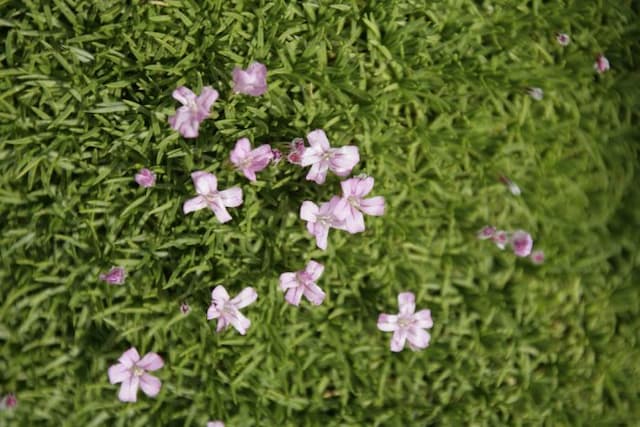
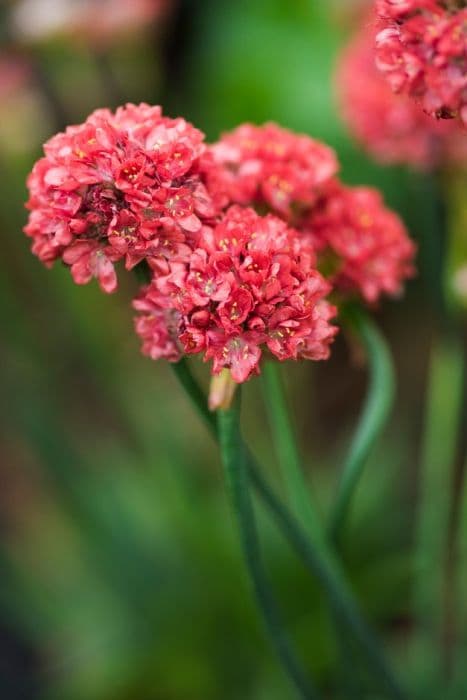
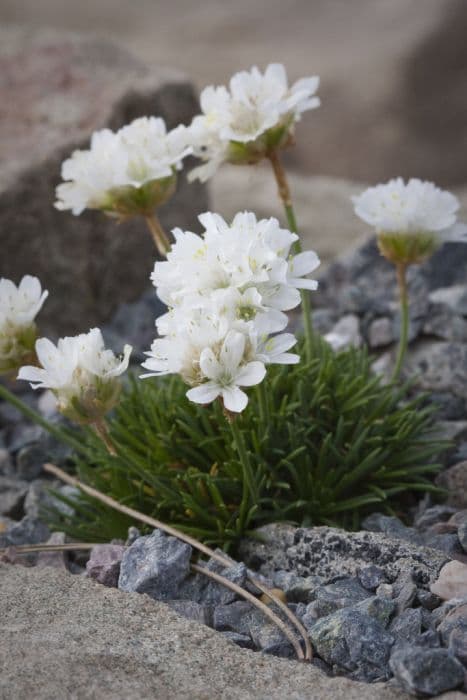
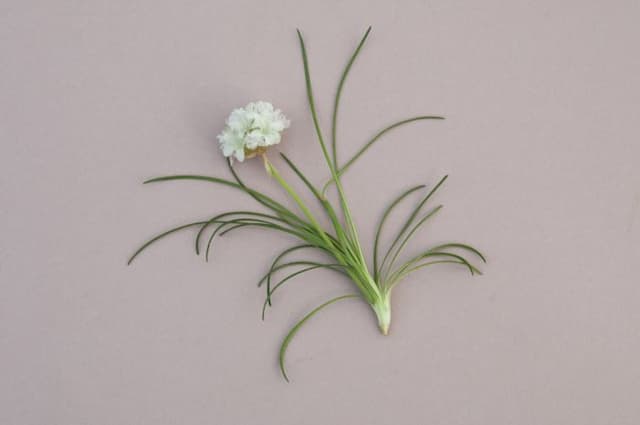
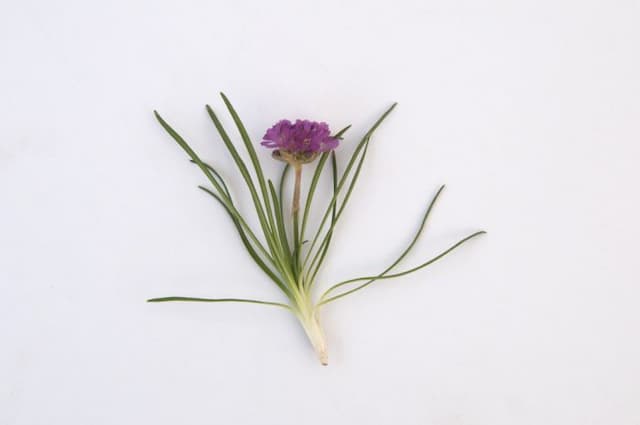



![Chinese plumbago [Forest Blue]](/_next/image?url=https%3A%2F%2Fplants-admin.emdemapps.com%2Fimages%2Fplants%2F%2Fimages%2F604b5c4db911f.png&w=640&q=75)
